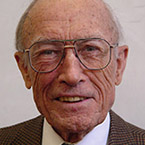Dinner is served. Grandmother Sally, alert and happy, is facing her first meal in some time in her son’s California ranch-style home. Her son Clyde is a comfortably fixed dairy cattleman who loves his wife Lela’s cooking a bit too much -– Uncle Clyde believes in eating generously. His trim mother Sally, daughter of a southern surgeon, Dr. Newport, takes a neat little serving, about four inches in diameter, of home-canned corn. Then comes salad with character – a larger serving. Next, she places some mellow lima beans on her plate like a tidy picture. There’s room to spare.

Suddenly, Clyde sounds out, “Sally, why don’t you eat!?”
(Softly) “…Clyde, I am a little woman, this is all I need.”
A few years later that central obesity of Uncle Clyde gets to him. He dies decades too young, of respectable conventionality, while his mother Sally keeps right on enjoying fun times with her children and her children’s children until she passes, like a queen, at 96!
What Made the Difference?
Grandmother Sally knew how to Live Better and Longer. Would you like to know how? Understanding this can help you, your family, and friends enjoy life and share happiness – years better and years longer. Older people used to be uncommon and out of sight. No more. Almost everyone is noticing them. The most rapidly growing population in the United States is people over 65 years old! Sixty-five is no longer the termination of life! Thousands are enjoying an extra decade or two of productive and enjoyable life.
Why, then, do people age too rapidly? When chemists analyze our body cells during aging, they find that even some of the molecules of these cells actually get out of shape and slow down the machinery! Environmental chemicals can split our chromosomes in the wrong places. Even the spiral staircase of our DNA can be bulged out of shape by abnormal additions to one step, called cytosine, of the DNA staircase. This can make our DNA dysfunctional, for resulting mutations can add up quietly and dangerously.1) Hazzard, W.R., et 211., Principles of Geriatric Medicine and Gerontology. McGraw Hill, N.Y., 1999, pp. 3-19.
Yung, R., et al, Unexpected effects of a heterozygous dnmt1 null mutation on age-dependent DNA hypomethylation and autoimmunity. J Gerontol A Biol Sci Med Sci, 56(6):B268-76, 2001, abs.
All normal body cells are surrounded by living, hard-working membranes. In short-lived people these membranes get too old too soon. In our bodies, power does not come from over the hills and far away through wires, greed, and political maneuvering. The power is made on location, inside the cells. No smog, smoke, or noise in the process. These nifty power plants are called mitochondria. In premature aging they atrophy and die off. Too early comes the thought, “I don’t feel like going with the children to the redwoods.”
Of course, the human body is the most complicated organism in creation. Starting with molecules, it has layers of complexity. Next in the hierarchy level are about 120 trillion cells. In graceful teamwork, several kinds of cells cooperate to form living, working tissues. Two or more types of tissues are engineered into many organs, like the heart. Then the organs interact with one another to form systems – for example, the digestive system. Then 12 of these splendid systems, like wheels within wheels, compose the masterpiece of creation, the whole person.
In aging research it is becoming clearer by the month that most aging is multifactoral. Apart from bullets and plane crashes, most aging involves decay, degeneration, and failure of life at more than one level, although it often focuses on one vital organ or system. The heart and the circulation, or the lungs and respiration, can fail gradually over a period of years. Not all the practical problems of typical aging can be understood or solved by one pet theory or one patented formula of chemistry or behavior. Many factors are involved.2)Crevecoeur, G.U., A system approach modelling of the three-stage non-linear kinetics in biological ageing. Mech Ageing Dev, 122(3):271~90, 2001, abs.

Sweet Angles
In his laboratory at the University of Texas, Dr. Masoro has shown that when blood sugar goes too high after you eat too much at a meal, this extra glucose and its byproducts can attack normal proteins, actually altering the shape of their molecules. This makes abnormal proteins – fibers are attacked, cross-linkages stiffen the body in the wrong places, albumen gets out of shape, hemoglobin is disordered, forming the abnormal tell-tale A1-c type! Even DNA can be attacked by the aggressive results of excess glucose. Chemists use the term glycation for this aspect of aging. Glycation takes place in all of us, diabetics or normal, when blood sugar goes too high-you don’t have to be diabetic for silent, stealthy, and dangerous things to happen. Just eat too much.3)Masoro, E.J., et al, Evidence for the glycation hypothesis of aging from the food-restricted rodent model. J Gerontol, 44(1):B20-2, 1989, abs.
Protein Turnover
As we age, the production of complicated proteins becomes more difficult and slower. Furthermore, the ability of the lysosomes (the digestive organelles) in the cells to eliminate fats and proteins is slowed down and weakened. Pieces of old membranes and scraps may stack up into microscopic junk piles in the cells and tissues. Instead of germs being destroyed, more often they may just be ejected.
Even Amino Acids
Other researchers have shown that even excess amino acids from splitting of proteins in the process of digestion can shorten the life span of cells.4)Jiang, J.C., et al, An intervention resembling caloric restriction prolongs life span and retards aging in yeast FASEB J, 14(4):2135-7, 2000, abs. And of course, the more excess protein you eat, the more seriously your kidneys may be damaged.
Free Radicals
When atoms or molecules in the body become electronically out of balance with an unpaired electron, they can become toxic, thus damaging the structures of proteins, enzymes, informational molecules coming from DNA, and even DNA itself. These free radicals can spread erosion, even ruin, in the biochemistry of cellular life. Some aspects of aging can be explained by the presence of more free radicals than the body can take care of with the vitamins, trace minerals, and protective factors it has available.5)Rowe, J.W., Aging and Geriatric Medicine, Chapter 6, in Cecil Textbook of Medicine, Part II, 19th Ed., Wyngaarden, J.B., et al., WB. Saunders, Philadelphia, Pa., c. 1992, pp. 21-26.
Health Habits Count
Let’s look at the early, classic studies by Dr. Breslow, of people living in Alameda County, California. People who reported good health habits in 1965, showed 9 years later, in 1974, much lower mortality rates. People thrived who, on the average, ate breakfast, didn’t eat between meals, got their exercise, enjoyed 7-8 hours of sleep, and of course were not obese, did not smoke, and avoided alcohols big perils. Disability was one-half as great, or with a 9 years delay, even in 1982/1983. Those whose health practices were intermediate demonstrated intermediate benefits.6)Breslow, L., and Breslow, N., Health practices and disability: some evidence from Alameda County. Prev Med, 22(1):86-95, 1993, abs.

The Immune System
There can be a 75% decline in T-lymphocyte function in aging.7)Rowe, J.W., Aging and Geriatric Medicine, Chapter 6, in Cecil Textbook of Medicine, Part II, 19th Ed., Wyngaarden, J.B., et al., WB. Saunders, Philadelphia, Pa., c. 1992, pp. 21-26. This immune senescence can help explain the dramatic rise of cancer risk in aging. Antibodies that should attack external enemies can be perverted to attack one’s own cells. These renegade antibodies are called ”autoantibodies.” This immune system ”civil war” can intensify with aging.
Aging-Associated Diseases
About one-half of affluent people succumb to cardiovascular disease. Millions more are handicapped or even made invalid because of heart and blood vessel diseases. In aging there is much interaction between atherosclerosis, moderate hypertension, and moderate obesity, thus accelerating the process.
The lungs are important also. Estimates are that each cigarette smoked chops about 13 minutes from the life span. Thousands of “coffin nails” do their thing! Lung cancer, emphysema, and chronic bronchitis can not only spoil the elder years, they can abolish them prematurely. Fortunately, educated people by the millions are swearing off smoking.
Kidneys are basic to happy, long life. Their job is to keep our blood clean and balanced. Kidneys are quite a bit like good oil filters. Mistreated oil filters can leave erosive dirt in the engine, then the engine goes “bye-bye” thousands of miles too soon!
Believe it or not, the soundness of the brain counts in longevity. Severe brain disease, via both nerves and hormones, can compromise not only the quality but also the length of life.
Accidents
In our fast moving world of travel, work, and recreation, to say nothing of accidents and crime, life can be terminated suddenly. Much of this carnage can be prevented by appropriate caretaking.
Psycho/Social Aspects of Aging
Negative psychological and social support have a bearing on the long-term happiness of life. Massive bereavement of losing a spouse can be incapacitating. when an elderly woman who has lived alone for years in the same nest is forced out to a foreign spot, the health outcomes can be serious. Rapid, unexpected loss of one’s autonomy and control of his life can be very damaging. Severe economic constraints, as in elderly people with very limited discretionary spending, or even not enough for life’s true necessities, take their toll. it is too common to sacrifice balanced nutrition for balancing the check book. Too bad. We need to be close to them, aware of and satisfying their needs as we are able.
Studies imply quite clearly that educational level has something significant to say about longevity. It is clear that social support and mental factors are significant.
Ways to Increase the Quality and Quantity of Life
Stop smoking, forever. It is the most common cause of the most common cancer in the affluent world – cancer of the lung in both men, and recently, in women. Tobacco is a killer. It promotes not only several cancers, but also heart and blood vessel disease, lung disease, and enough other carnage to be outlawed in any alert, smart, and with-it nation.
Drugs are another threat to abundant living. Street drugs kill faster, prescription drugs kill more slowly. Some drugs tend to keep people from facing up to the real causes of their afflictions and reforming their lifestyle to help nature to combine with good wholistic scientific care to bring about long-term healing.
Alcohol can tranquilize, but its side effects are decimating. About one-half of our highway deaths are associated with alcohol. Many of these are of innocent victims. About 10% of people who start drinking become problem drinkers and alcoholics. Alcohol destroys frontal lobe brain cells, even at lower doses, throughout the period of years. Alcohol promotes cancer of the breast, mouth, throat, esophagus, liver and others. No wonder that the wise man, Solomon, wrote in the Bible, no doubt both from inspiration and observation, “Wine is a mocker, strong drink is raging: and whosoever is deceived thereby is not wise.” Proverbs 20:1, KJV
Instead of drinking dilute poison, drink more good clean water! Eight to ten full glasses of water per day will do much to wash away the byproducts of the body. Remember those 120 trillion cells in your body? Each of them thrives on clean blood and tissue fluids. Wash ‘em!
Exercise Moderately and Regularly
Exercise improves insulin sensitivity. It also helps the body use up glucose in the blood and helps prevent or reduce obesity and heart disease. The organs of the body must not be allowed to ”rust out” from inaction. Exercise is a vital part of good living.
Understand the importance of Genetics
Would you believe it? More than 300 genes that impact length of life have been found.8)Budovsky A. et.al. LongevityMap: a database of human genetic variants associated with longevity. https://doi.org/10.1016/j.tig.2013.08.003 This helps explain why longevity tends to run in families. We cannot preselect our grandparents, but we can modify the expression of their genes in our bodies.
Importance of Diet
Really great info here! In the 1930’s a professor at Cornell University, Dr. Clive McKay, made a breakthrough discovery. Backing off on the amount of food eaten would extend the life span dramatically. Restricting the calories has turned out to be the single most powerful, most significant way to increase the life span known to science!
The Jackson Lab Story
The most famous lab in the world for study of heredity in mice is the Jackson Laboratory in Bar Harbor, Maine. Literally millions of genetically defined mice have been studied, bred, and shared throughout the research world. On the cutting edge of biogenetics, the researchers report that conventional mice in clean, air-conditioned environments live about 900 to 1,000 days. Then after years of genetic manipulation to maximize longevity they have produced a mouse that lived 1,393 days. But listen to this! On the trim diet pioneered by Clive McKay, which provided 40% fewer calories, the scientists produced ”Freddy,” who lived 1,742 days! This is two years longer than the conventional mouse-feeding program, on which the animals eat all they care to. The trim program wins handsomely.9)Harrison, ”Zorba Benefits Aging Research.” Inside the Jackson Lab, Bar Harbor, Maine, Spring 1998, p.5.

Scientific Advantages of a Trim Diet
- On the trim diet, instead of just existing in a sedentary state the mice seemed to become almost a new breed of animal. When both control and trim diet animals have free access to running wheels, the control animals run only 1,000 meters per day. Those on the trim diet run an amazing 5,000 meters per day!10)Spindler, S., ”Gene Chips: What they are telling us about aging, diet, and drugs.” APC Convention, Loma Linda University, Loma Linda, Ca., 2001.
- Consider a task requiring higher brain functions. When the two classes of animals are measured in maze performance, the trim class wins, and the others lose.
- Regarding body fat – just like you would think – the trim ones have more muscle and less fat.
- The immune function of the trim animals is superior.
- They also have evidences of less oxidative stress in their tissues, as indicated by chemical measurement.
- After their meals they show less elevation of blood glucose, which means less glycation.
- Accordingly, these trim animals have less cross-linkage of the fibers throughout their bodies.
- The number of dopamine receptors is increased. These are highly specially tailored molecules that enable dopamine to stimulate certain nerve cells in the brain, and thus reduce depression.11)Masoro, E.J., et al, Evidence for the glycation hypothesis of aging from the food-restricted rodent model. J Gerontol, 44(1):B20-2, 1989, abs.
- Diabetes is much less of a problem.
- There is less kidney erosion, inflammation, and failure.12)Stern, J.S., et al., Calorie restriction in obesity: prevention of kidney disease in rodents. J Nutr, 131 (3):913S-917S, 2001, abs.
- In rhesus monkeys, the triglycerides are lower on the trim diet.13)Cefalu, W.T., In vitro oxidation of low density lipoprotein in two species of nonhuman primates subjected to caloric restriction. J Gerontol A Biol Sci Med Sci, 55(7).B355-61, 2000, abs.
- Emerging data from trim diets in monkeys “strongly support” several decades of research on smaller animals.14)Lane, M.A., et al, Nutritional modulation of aging in nonhuman primates. J Nutr Health Aging, 3(2):69-76, 1999, abs.
- Decline of kidney function and failure, which is relevant in human geriatrics, is less, and delayed.
- Not only are there fewer tumors and cancer in animals on the trim program, the ones that do appear are smaller, and less aggressive when they do occur.
- There is much less heart and vessel disease on the trim program, as well as obviously much less obesity and improved control (lipolysis) of fat.15)Masoro, E.J., et al, Evidence for the glycation hypothesis of aging from the food-restricted rodent model. J Gerontol, 44(1):B20-2, 1989, abs.
It is thus becoming very obvious that the trim program, consisting of eating less and exercising more, is a clear-cut winner for adding life to your years and years to your life.
These trim animals, with the same genetics and same environment as those eating all they want, have less DNA damage and better DNA repair in circumstances where mutagens or carcinogens damage DNA. No wonder these abstemious animals get much less cancer!16)Yoshida, K., et al., Calorie restriction and spontaneous hepatic tumors in C3H/He mice. J Nutr Health Aging, 3(2): 121-6, 1999, abs.
Enter the Gene Chip
Springing from computer chip technology, bioengineers have developed silicon spot-coded chips that can deliver qualitative and even semi-quantitative fingerprints of the genes! Using these very new and quite expensive gene-chip analyzers (or micro-array processors) they have shown that in the mouse there are 22 genes known to affect aging and longevity (as of the year 2001). What is happening biochemically in aging? These 22 vulnerable genes go out of control. They are overexpressed.
But, GOOD NEWS, fifteen out of these twenty-two are normalized by the trim program.
Also, more exciting news-some of the genes in aging do the opposite. They are under-expressed, genetically. Examples are the genes superintending detoxification in the liver and those duplicating new DNA. They decrease seriously, but with the trim program they continue to function more nearly normally.
These new measurements of the genetic and biochemical mechanisms of successful aging are breakthroughs indeed, No wonder activity, brain performance and life span are dramatically improved with caloric restriction.
Even if the trim diet is delayed until the animals are quite old, 9 of the 22 genes can show normalized gene expression within 1 month on the trim program.17)Cefalu, W.T., In vitro oxidation of low density lipoprotein in two species of nonhuman primates subjected to caloric restriction. J Gerontol A Biol Sci Med Sci, 55(7).B355-61, 2000, abs.
Eat More Wisely
Enlightened moderation is the key. Malnutrition is, of course, decimating. Even the brain can be permanently shrunk by serious food deficiency in very young children. Overeating is deadly, as we have seen above. But enlightened moderation in eating is basic to the most successful aging, with its vigorous accompanying activity of brain and body, and resistance to cardiovascular disease and cancer.
Beyond Just Trim Quantity-Quality of Food
Decades of human epidemiological studies such as the Adventist Health Studies involving thousands of people, have clearly shown that people who live on excellent first-hand food emphasizing more fruits, vegetables, whole grains, and nuts, and less second-hand food of animal origin, are favored with longevity and relative freedom from chronic diseases that plague affluent societies.
Quality of Social and Spiritual Support
It is becoming increasingly clear that strong, friendly, family, social, and spiritual supports tend to foster happy, enduring lives enriched by relationships that reduce abrasive stressors and-contribute not only the meaning of life but that “length of days” that the Bible promises.
Solomon was right when he wrote, ”My son, forget not my law; but let thine heart keep my commandments: for length of days, and long life, and peace, shall they add to thee.” Proverbs 3:1,2, KJV

Stay Always Up to Date
Sign up to our newsletter and stay always informed with news and tips around your health.

Bernell E. Baldwin, PHD, specialized in Neurophysiology. He taught many students, doctors and lifestyle guests at Wildwood Institute. He was also active in research and teaching at the Schools of Medicine and of Health at Loma Linda University, Loma Linda, CA.
References
| ↑1 | Hazzard, W.R., et 211., Principles of Geriatric Medicine and Gerontology. McGraw Hill, N.Y., 1999, pp. 3-19. Yung, R., et al, Unexpected effects of a heterozygous dnmt1 null mutation on age-dependent DNA hypomethylation and autoimmunity. J Gerontol A Biol Sci Med Sci, 56(6):B268-76, 2001, abs. |
|---|---|
| ↑2 | Crevecoeur, G.U., A system approach modelling of the three-stage non-linear kinetics in biological ageing. Mech Ageing Dev, 122(3):271~90, 2001, abs. |
| ↑3, ↑11, ↑15 | Masoro, E.J., et al, Evidence for the glycation hypothesis of aging from the food-restricted rodent model. J Gerontol, 44(1):B20-2, 1989, abs. |
| ↑4 | Jiang, J.C., et al, An intervention resembling caloric restriction prolongs life span and retards aging in yeast FASEB J, 14(4):2135-7, 2000, abs. |
| ↑5, ↑7 | Rowe, J.W., Aging and Geriatric Medicine, Chapter 6, in Cecil Textbook of Medicine, Part II, 19th Ed., Wyngaarden, J.B., et al., WB. Saunders, Philadelphia, Pa., c. 1992, pp. 21-26. |
| ↑6 | Breslow, L., and Breslow, N., Health practices and disability: some evidence from Alameda County. Prev Med, 22(1):86-95, 1993, abs. |
| ↑8 | Budovsky A. et.al. LongevityMap: a database of human genetic variants associated with longevity. https://doi.org/10.1016/j.tig.2013.08.003 |
| ↑9 | Harrison, ”Zorba Benefits Aging Research.” Inside the Jackson Lab, Bar Harbor, Maine, Spring 1998, p.5. |
| ↑10 | Spindler, S., ”Gene Chips: What they are telling us about aging, diet, and drugs.” APC Convention, Loma Linda University, Loma Linda, Ca., 2001. |
| ↑12 | Stern, J.S., et al., Calorie restriction in obesity: prevention of kidney disease in rodents. J Nutr, 131 (3):913S-917S, 2001, abs. |
| ↑13, ↑17 | Cefalu, W.T., In vitro oxidation of low density lipoprotein in two species of nonhuman primates subjected to caloric restriction. J Gerontol A Biol Sci Med Sci, 55(7).B355-61, 2000, abs. |
| ↑14 | Lane, M.A., et al, Nutritional modulation of aging in nonhuman primates. J Nutr Health Aging, 3(2):69-76, 1999, abs. |
| ↑16 | Yoshida, K., et al., Calorie restriction and spontaneous hepatic tumors in C3H/He mice. J Nutr Health Aging, 3(2): 121-6, 1999, abs. |
Leave a Reply